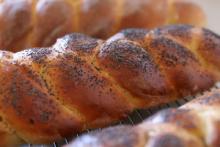Challah is the traditional ritual bread of the Jewish people. Its recipe dates back as far as the Jewish exile in Babylon and possibly earlier. In addition to being a very tasty, unique food, challah is a deeply symbolic item. Its ingredients are rich and luxurious, certainly too costly to be used for everyday bread. Challah is the bread of the sabbath, an aesthetically pleasing sacrament that is not only the beginning of the shabbat meal, it is also a confluence of symbols.
To make a loaf of challah from scratch, first combine the following wet ingredients.
- 1 cup of warm water
- 1.5 to 2 teaspoons of active dry yeast, sprinkled over the water
- 1/2 cup of milk
- 1/2 cup of honey
- 2 tablespoons of vegetable oil
- 2 eggs
- 1.5 teaspoon of salt
After all of these ingredients are completely combined, add four cups of all-purpose flour to the mixture, one cup at a time. Make sure each cup of flour is fully incorporated before adding the next cup. Beat the mixture until it is smooth and no longer sticky. You may need to add a few more pinches of flour while mixing. Next, cover the dough with a damp cloth for at least an hour while it expands. When it has reached approximately double its size, divide the dough into three, inch-thick "snakes" then pinch one end of each together and braid the pieces together into a loaf. Place the loaf in a warm place under a damp cloth and let it rise for an hour. Then, brush the loaf with one beaten egg and sprinkle with poppy seeds. Place the loaf in an oven preheated to 375 degrees and bake for 40-45 minutes. The challah should come out with a golden brown crust and make a hollow sound when you tap the bottom. Let it cool for an hour, then slice. The bread should have a slight yellow tint and a sweet, mildly cakey flavor.
As you can see, challah is an unusual bread. Most breads don't use so much (or any) egg and honey, nor are most breads braided. What is the meaning of these strange things? As previously noted, challah is a luxurious ritual bread. It is meant to have rich, flavorful ingredients. Milk and honey are famously the two descriptors of the Promised Land in the Torah. They are symbols of prosperity and joy. Milk is an indication of plentiful livestock, which for a pastoral people like the Hebrews were the main sources of wealth. Honey was a rare delicacy that was difficult to harvest. Having both of those things in the bread makes it a symbol of material comfort.
The egg is a symbol of fertility in practically every culture on Earth. Eggs are prominent ingredients in challah, indicating the value of family in Jewish philosophy. Poppy seeds, which aren't present in all challah recipes, refer to the highest luxuries of the ancient Near and Middle East. Poppy flowers were associated with grand kingdoms like Persia and Lebanon. As for why challah is braided, that was a later addition in the Ashkenazi tradition. The braid is a symbol of plurality, referring both to the strength of community and the many aspects of creation. Braided bread, just like braided candles and braided hair, symbolize the unity of the Jewish people.
Challah is a delicious, unique bread and one of Jewish culture's great contributions to the kitchen. Making it at home is easy and it pairs well with other Jewish favorites like chicken soup and red wine, as well as butter, jam or even as a base for French Toast. Sweet, dense and beautiful, challah is the food of Jewish ritual.
